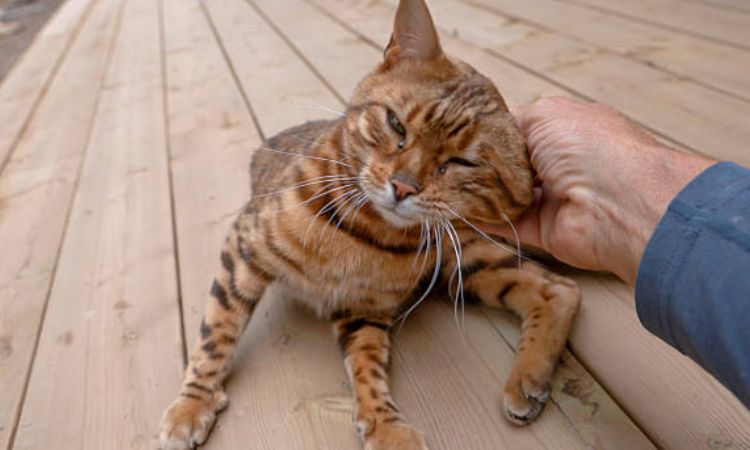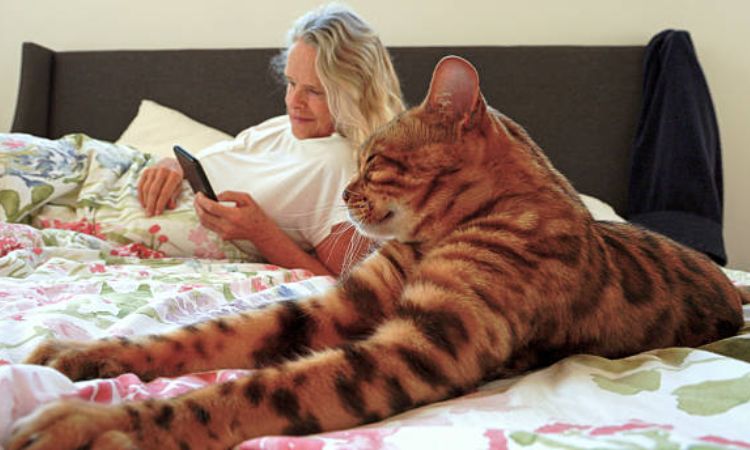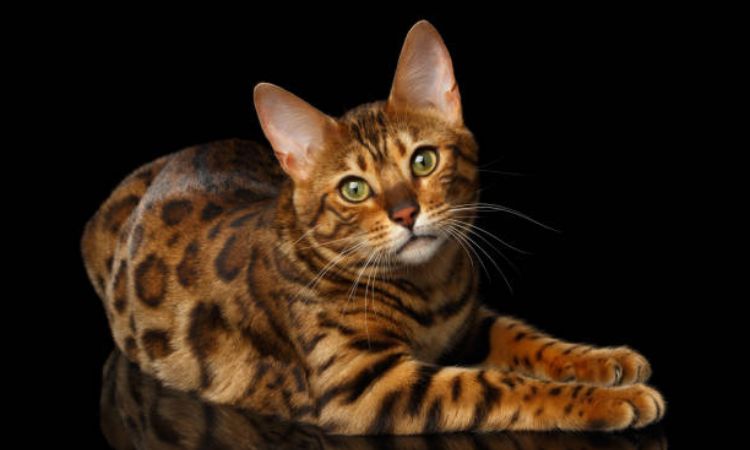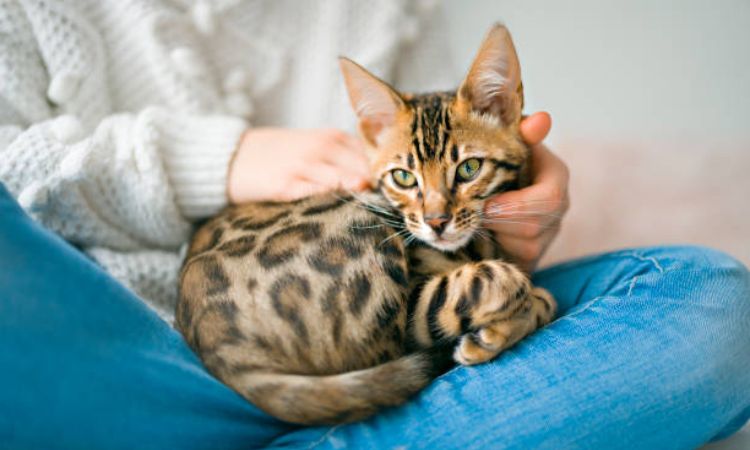Bengal cats are instantly captivating—their sleek, spotted coats and graceful movements give them the look of a miniature leopard. Yet behind their exotic appearance is a playful, intelligent, and affectionate companion who loves both adventure and human company.
In this section Nexus Pets presents The Bengal Cat: A Comprehensive Guide to Size, Characteristics, Lifespan, and Coat Colors.

Bengal Cat Characteristics & Temperament
Bengal cats are known for their striking looks, but it’s their personality that truly sets them apart. Intelligent, endlessly curious, and brimming with energy, Bengals are not the type to lounge around all day. They thrive in environments that challenge their minds and bodies, making them a rewarding—but sometimes demanding—companion for experienced cat parents.
Behavioral Traits
- High Energy
Bengals are natural athletes. They love to climb, leap, and chase, often requiring more exercise and stimulation than many domestic breeds. Without enrichment—such as cat wheels, puzzle feeders, or vertical climbing spaces—they may become bored and resort to destructive behaviors. - Love of Water
Unlike most cats, Bengals often display a fascination with water. Some will dip their paws into their water bowls, splash in the sink, or even join their owners in the shower. This quirk reflects their wild ancestry and adds a playful dimension to their personality. - Vocalizations
Bengals are talkative felines with a wide vocal range. Beyond typical meows, they produce distinctive chirps and chatters, especially when observing birds or asking for attention. Their expressive voices make them excellent communicators but may surprise those expecting a quieter pet. - Socialization
When properly socialized, Bengals form strong bonds with their families. They are affectionate and loyal, though not always fond of being held for long periods. With children, their high energy can be a double-edged sword—they enjoy interactive play but may be overwhelming for very young kids. Bengals can coexist with other pets, including dogs, though their strong prey drive means smaller animals may not be safe companions.
Bengal Cat Size, Weight, and Growth
Bengal cats are striking not just for their exotic appearance but also for their athletic, muscular build. Understanding their size, weight, and growth patterns can help you provide the right care and ensure your Bengal grows up healthy and strong.
Size at a Glance
Here’s a quick reference for the average size and weight of Bengal cats:
| Trait | Average Range |
| Height | 13–16 inches |
| Weight | 8–17 pounds |
| Body Type | Medium to large, muscular, lean |
Bengals have a well-proportioned, athletic frame with longer hind legs than front legs, giving them a graceful and powerful stride. Their sleek bodies and compact, round heads contribute to their wild yet elegant appearance.
Male vs. Female Size
Like many cat breeds, male Bengals tend to be slightly larger than females. On average:
- Male Bengals: 10–17 pounds, slightly taller and more robust.
- Female Bengals: 8–14 pounds, slightly smaller but still muscular and active.
Despite these general trends, individual Bengals may vary depending on genetics and generation (F1–F5+), with lower-generation Bengals often being larger and more energetic than higher-generation cats.

Growth and Development
Bengal kittens grow rapidly during their first year of life, developing their signature muscular build and spotted coat patterns as they mature. Here’s a typical growth timeline:
- Birth to 2 Weeks: Tiny and fragile; eyes begin to open around 7–10 days.
- 2–6 Weeks: Rapid growth; playful behaviors emerge, and weaning usually begins.
- 6–12 Weeks: Socialization is critical; kittens learn play, hunting skills, and curiosity is evident.
- 3–6 Months: Growth spurt continues; energy levels are extremely high; adult coat begins developing.
- 6–12 Months: Lean, muscular frame becomes more defined; personality and activity level stabilize.
- 12–18 Months: Full adult size reached for most Bengals; females may mature slightly faster than males.
Bengal cats typically reach their full size by around 12–18 months, though their energy and playful behaviors often continue well beyond this age.
Factors Affecting Size
Several factors influence how big your Bengal cat will grow:
- Genetics: The generation of your Bengal (F1–F5+) and the size of the parents play a major role in adult size. F1 or F2 Bengals are often larger due to closer ancestry to the wild Asian leopard cat.
- Diet: Proper nutrition is essential for healthy growth. Feeding a high-quality, balanced cat food ensures your Bengal develops strong muscles and maintains a lean build. Avoid overfeeding, which can lead to obesity and strain on joints.
- Overall Health: Regular veterinary checkups, vaccinations, and parasite prevention contribute to healthy growth. Chronic illnesses or congenital conditions can impact size and development.
- Exercise and Environment: Bengals are highly active cats that thrive on stimulation. Adequate space, climbing opportunities, and playtime support healthy muscle development and overall physical fitness.
By understanding these size and growth factors, you can ensure your Bengal cat matures into a strong, agile, and vibrant adult—ready to charm with its wild beauty and playful personality.
Lifespan and Common Health Considerations
Average Lifespan
Bengal cats are generally healthy and can live 12 to 16 years with proper care. Their longevity depends on genetics, diet, exercise, and routine veterinary care. While Bengals are hardy compared to some breeds, regular check-ups and preventive care are essential for ensuring a long, healthy life.
Common Health Issues in Bengal Cats
Bengals are prone to a few genetic and health conditions. Being aware of these risks and working with a responsible breeder can help mitigate potential problems:
- Progressive Retinal Atrophy (PRA)
- PRA is a genetic condition that causes the gradual deterioration of the retina, eventually leading to blindness.
- Symptoms may include night blindness or difficulty navigating in dim light.
- Ethical breeders perform genetic testing on both parent cats to reduce the likelihood of PRA in kittens.
- Feline Infectious Peritonitis (FIP)
- FIP is a viral disease caused by a mutation of feline coronavirus.
- While it’s relatively rare, FIP can be fatal if not addressed early.
- Signs include fever, weight loss, lethargy, and fluid buildup in the abdomen or chest.
- Hypertrophic Cardiomyopathy (HCM)
- HCM is the most common heart disease in cats and involves thickening of the heart muscle.
- Often, symptoms are subtle until the disease progresses, making routine veterinary exams critical.
- Reputable Bengal breeders should genetically screen parent cats to minimize the risk of HCM in offspring.
Note: Choosing a reputable breeder is key to reducing the risk of genetic conditions. Look for breeders who provide health guarantees, perform genetic testing, and prioritize the wellbeing of their cats.

Caring for Your Bengal Cat
Maintaining your Bengal’s health involves a combination of proper nutrition, exercise, and regular veterinary care:
- Balanced Diet: Feed a high-quality, nutritionally complete cat food that meets AAFCO guidelines. Adjust portion sizes based on your Bengal’s age, weight, and activity level. Avoid free-feeding to prevent obesity.
- Regular Exercise: Bengals are highly active and intelligent. Provide climbing structures, interactive toys, and play sessions to stimulate both their mind and body.
- Routine Vet Visits: Schedule annual wellness exams, dental cleanings, and vaccinations. Early detection of health issues such as HCM, PRA, or gastrointestinal problems can make treatment more effective.
- Preventive Care: Use parasite preventatives, monitor weight, and keep your cat’s environment safe and enriched to reduce stress and maintain overall health.
- Enrichment: Incorporate food puzzles, climbing shelves, cat wheels, and supervised water play to engage your Bengal’s natural curiosity and hunting instincts.
The Beautiful Bengal Cat Coat: Colors and Patterns
Bengal cats are among the most visually stunning domestic cats, often compared to mini leopards due to their wild appearance. Their beauty comes not only from their athletic build but also from their distinctive coat patterns, vibrant colors, and unique shimmering effect known as glitter.
Coat Patterns
Bengals primarily display two main coat patterns:
- Spotted Pattern
The spotted coat is the classic Bengal look, instantly recognizable and leopard-like. Spots vary in size and shape, and in some cats, spots form rosettes, two-toned markings that mimic wild big cats. Popular rosette types include:- Arrowhead: Triangular spots pointing backward along the cat’s torso.
- Donut: Circular rosettes with a dark outline and lighter center.
- Paw-print: Shaded spots resembling small paw prints.
Other variations include clouded, chain, and cluster rosettes, which create intricate patterns inspired by jaguars, ocelots, and clouded leopards.
- Marbled Pattern
The marbled pattern features swirling, asymmetrical stripes derived from classic tabby patterns. Ideal marbled Bengals have horizontal-flowing, randomly arranged swirls in two or more colors. Subtypes include reduced horizontal flow, horizontal flow, chaos, and sheet marble.
Sparbling is a hybrid style where marbling mixes with rosettes, producing a unique spotted-marble combination.
Coat Colors
Bengal cats come in a wide variety of colors, categorized into standard and non-standard / rare by The International Cat Association (TICA).
Standard Colors
- Brown Bengal
The most common and widely recognized Bengal color. Browns range from golden-tawny to orange-gold, with black or dark brown spots, rosettes, or marbling. Typical features include a black-tipped tail, red nose, and green or gold eyes. - Snow Bengal
Snow Bengals are pale and striking, resembling miniature snow leopards. There are three genetic variations:- Seal Lynx: Creamy white with dark markings and always blue eyes.
- Seal Mink: Ivory or light tan with seal-colored markings and aqua or blue-green eyes.
- Seal Sepia: Creamy or light tan with seal sepia markings and green or gold eyes.
- Silver Bengal
Silver Bengals have a shimmering coat created by the inhibitor gene, which reduces warm tones. Their base ranges from nearly white to steel gray, contrasted with dark gray or black markings, a black-tipped tail, and green or golden eyes.

Non-standard / Rare Colors
- Charcoal Bengal
Charcoal Bengals are darker, often with a smoky gray or carbon-colored base. Some display a distinctive dark face “mask” and dorsal stripe called the “Zorro cape.” Charcoals can appear in brown, silver, or snow Bengals. - Blue Bengal
Blue Bengals are rare and have a soft powdery blue-gray coat with darker blue or steel gray markings. Both parents must carry the recessive gene for a blue Bengal kitten. - Melanistic (Black) Bengal
Solid black Bengals have “ghost” markings barely visible in daylight. Silver smoke is the silver variation of a melanistic Bengal, offering a smoky, ethereal appearance.
The Glitter Gene
One of the most magical traits of Bengal cats is glitter—a shimmering effect in the coat caused by translucent, hollow hair shafts that catch light. Glitter is more pronounced in some cats than others and gives the coat a sparkling appearance, even in low lighting, adding to the breed’s exotic allure.
Bengal cats combine a wild, athletic appearance with an intelligent, playful personality. Their striking coat patterns—from spotted rosettes to marbled swirls—and diverse colors make each cat unique. With proper care, nutrition, and regular vet check-ups, Bengals thrive as active, affectionate companions, leaving a lasting impression with their beauty and energy.






